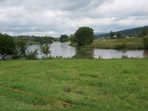5.8 Conditional Workflows
CHPS can be configured to help the forecasters in many ways. One way to improve user experience is to create conditional workflows. Conditional workflows run when triggered and could provide data for various forecast scenarios.
Conditional workflows run if triggered by a threshold or window around a peak moment of a long time series. Conditional workflows are very effective when hindcasting, performing model comparison, or for more efficient forecasting of atypical situations.
Example: A segment is at bank full so any additional precipitation or upstream flow will cause overland flooding.
Set up a workflow to run after the segment reaches flood stage. The workflow could update the forecast more often or pull in data for the segment more frequently.
Set Up
Setting up conditional workflows is very similar to setting up daily workflows. The basic steps include:
- Create additional workflows for conditional situations.
- Register the workflow.
- Define the thresholds or window to activate the workflow.
Steps one and two follow standard workflow creation procedure.
The hierarchical arrangement of workflows creates opportunities for system optimization. Rearranging the workflows speeds up the system.
Try it out! Practice Exercise: Conditional Workflows
Activate the Workflow
The last step in the procedure creates a file to activate the workflow. The file, called WorkflowLoopRunner.xml is located in the RegionConfigFiles directory. Define the following parameters:
- Trigger option
- Trigger time series
- Relative view period
- Value option
- Value
- Relative run window
The WorkflowLoopRunner.xml file follows the schema workflowLoopRunner.xsd. Use the schema to determine useful options for your RFC and create conditional workflows for various situations your forecasters encounter.
Use the following job sheet to learn how to develop a conditional workflow.
Job Sheet: Creating a Conditional Workflow


